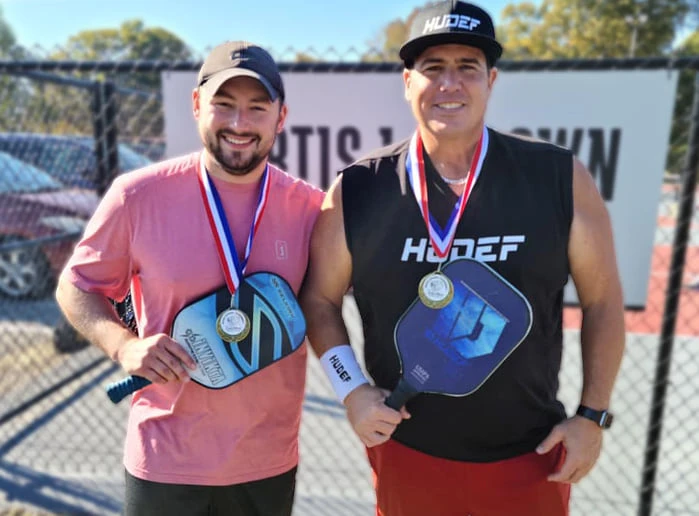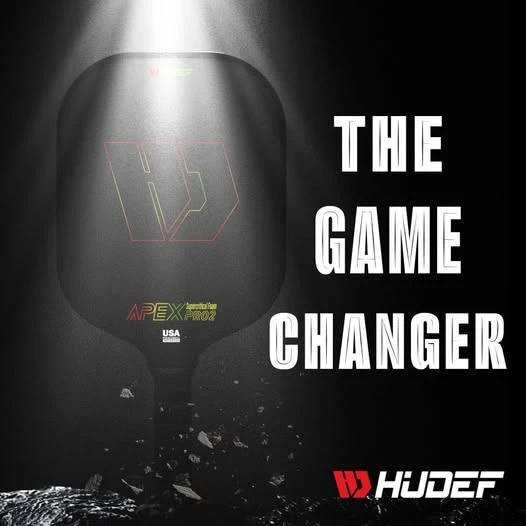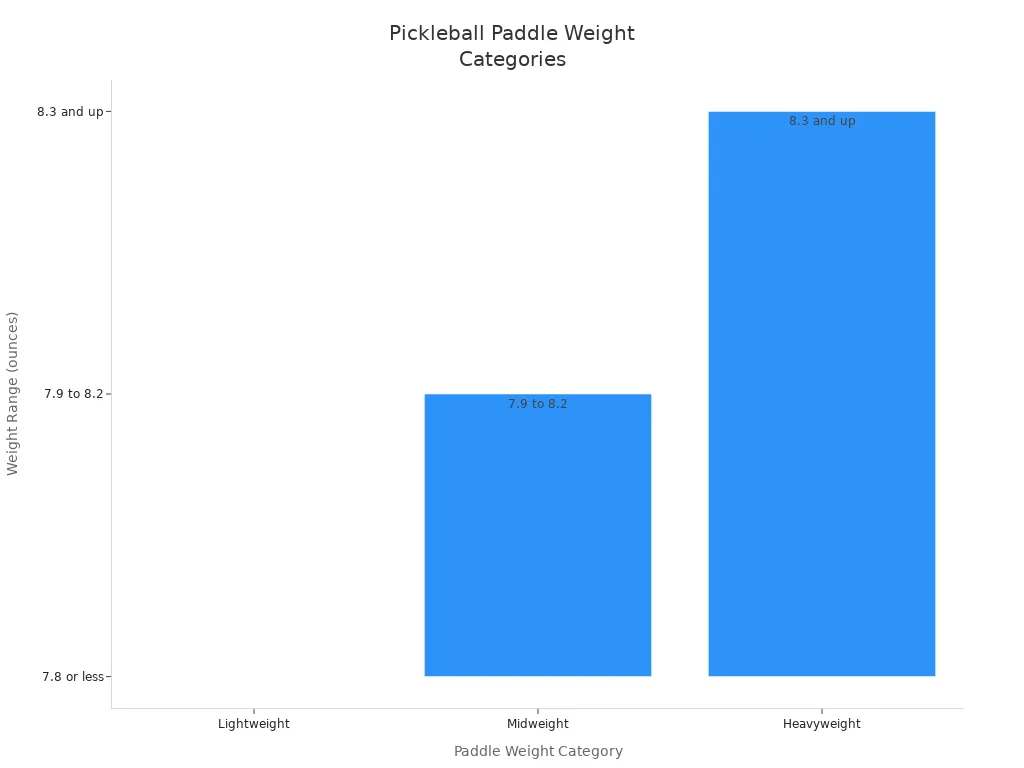
Picture yourself playing pickleball with hudef pickleball paddles. You swing your pickleball paddle and sometimes miss shots you thought you could hit. Maybe your arm feels tired, or you struggle to control the ball. Often, the real reason is your pickleball paddle’s balance. When you use Good Balance Pickleball Rackets Weakness Kill technology, your paddle has the perfect swingweight, helping you react faster, feel less tired, and gain better control. Many players pick paddles that are too heavy or too light, but few consider the advantage of a well-balanced paddle. If your paddle feels heavy at the top, fatigue sets in quickly, and control suffers. A lightweight, balanced pickleball paddle from hudef helps you move faster and play longer. The Good Balance Pickleball Rackets Weakness Kill concept demonstrates how the right paddle can transform your game. Check out this table to see how swingweight impacts your play:
|
Aspect |
Impact on Missed Shots |
Impact on Fatigue |
Impact on Control |
|---|---|---|---|
|
Heavier swingweight |
More missed shots |
More fatigue |
Less control |
|
Lighter swingweight |
Fewer missed shots |
Less fatigue |
Better control |
To play your best pickleball, try different hudef pickleball paddles and find the one with the perfect balance for you. Experience the difference that Good Balance Pickleball Rackets Weakness Kill can make in your game.
Key Takeaways
-
A balanced pickleball paddle shares its weight evenly. This gives you more power and control. You can make better shots and feel less tired.
-
Good Balance Pickleball Rackets Weakness Kill technology uses smart design. It has honeycomb cores and shock absorption. These features lower vibration and make the sweet spot bigger. They also help you control the ball better.
-
Picking the right paddle weight and balance helps you play longer. You can react faster and hit more accurate shots. Your shots can also be stronger.
What Is Balance in Pickleball Rackets?
Defining Paddle Balance
When you pick up a pickleball paddle, you might notice how it feels in your hand. That feeling comes from the way the paddle’s weight is spread out. Some paddles have more weight near the head, while others feel heavier at the handle. A balanced paddle has its weight spread evenly from top to bottom. This even distribution gives you a mix of power and control. If you want to play all-around pickleball, a balanced paddle is a smart choice. You get the best of both worlds—enough power for strong shots and enough control for soft touches. Most balanced paddles fall into the middleweight or lightweight category, making them easy to swing and quick to move.
Tip: Try holding a paddle flat on your finger at the middle. If it stays level, you’ve found a balanced paddle!
Why Balance Matters
Balance can change how you play pickleball. If your paddle is head-heavy, you might hit harder, but you could lose control on quick shots. A handle-heavy paddle helps with fast reactions but may lack power. A balanced paddle lets you switch between power and control with ease. Scientific studies show that when a paddle’s vibration and weight are balanced, you get more power and better shot accuracy. You also reduce the risk of arm fatigue. Many players think heavier paddles always mean more power, but technique and paddle design matter more. Lightweight and balanced paddles help you react faster and play longer without getting tired. If you want to improve your pickleball game, focus on finding a paddle with the right balance for your style.
|
Paddle Type |
Power |
Control |
Best For |
|---|---|---|---|
|
Head-Heavy |
High |
Low |
Aggressive singles play |
|
Handle-Heavy |
Low |
High |
Quick volleys, defense |
|
Balanced |
Good |
Good |
All-around, doubles |
Good Balance Pickleball Rackets Weakness Kill
Common Player Weaknesses
When you play pickleball, you may have problems. You might hit the ball off the edge. Your arm can feel sore after playing for a while. Sometimes your paddle wears out quickly. You may not be able to control the ball well. These problems are common for many players:
-
Small sweet spot: You lose power and control if you miss the center.
-
Vibration: Your arm and wrist feel shock, which makes you tired or sore.
-
Surface wear: The paddle face gets rough or chipped, which hurts your play.
-
Poor ball control: You find it hard to place shots or add spin, especially when you dink.
These problems can make pickleball less fun. They can stop you from playing your best. You do not have to live with these issues. Good balance pickleball rackets weakness kill technology helps fix these problems with smart design.
Tip: If your shots are weak or your dinks go wild, your paddle could be the problem, not your skills.
How Balance Eliminates Weaknesses
Let’s look at how the right paddle features help you play better. Good balance pickleball rackets weakness kill technology uses strong materials and smart building to solve these problems.
|
Technical Feature |
What It Does for You |
Weakness It Kills |
|---|---|---|
|
Honeycomb Core |
Makes the sweet spot bigger, gives you more power, and absorbs shock |
Small sweet spot, vibration |
|
Shock Absorption System |
Cuts down vibration, protects your joints, and lets you play longer |
Vibration, fatigue |
|
Durable Surface Tech |
Keeps your paddle face strong and smooth, even after lots of hits |
Surface wear |
|
Precision Control System |
Helps you control the ball, add spin, and place perfect dinks |
Poor ball control |
|
Balanced Weight Design |
Makes the paddle easy to swing, giving you both power and control |
All-around weaknesses |
Honeycomb core technology gives you a bigger sweet spot. You keep your power, even if you miss the center. The paddle forgives mistakes, so you can focus on your game. Shock absorption systems, like foam layers and gel handles, soak up vibration. Your arm and wrist stay comfortable, so you can play longer.
Durable surface technology, like titanium alloy coatings, keeps your paddle strong and smooth. You do not need to buy a new paddle often. Precision control systems, like micro-textured surfaces, help you grip the ball better. You can add spin and place your dinks more accurately.
Balanced weight design is very important. When your paddle has good balance, you get power and control. You can hit strong shots and switch to soft dinks at the net. You react faster, move easier, and feel less tired. Good balance pickleball rackets weakness kill technology brings all these features together. You can focus on your game and have more fun.
Note: Many top players pick paddles with honeycomb cores and shock absorption. They want more power, less vibration, and better control. You will notice the difference in every shot.
When you use a paddle with these features, you fix your weaknesses and play your best. Your shots get stronger, your dinks get better, and you improve your game. Good balance pickleball rackets weakness kill is not just a saying—it helps you play better.
Pickleball Paddle Weight & Performance

Impact of Paddle Weight
When you pick up a paddle, the first thing you notice is its weight. Paddle weight changes everything about your pickleball game. If you use a lightweight paddle, you swing faster and control the ball better. You feel less tired after long rallies. Lightweight paddles help you react quickly and place shots with accuracy. Sports science shows that lightweight paddles increase contact time with the ball, so you get more spin and control. If you want to know who should use a lightweight paddle, beginners and players with arm injuries do best with this option.
Heavy pickleball paddles give you more power. When you swing a heavy paddle, you hit harder and send the ball farther. The extra weight adds stability, which helps advanced players who want strong shots. But heavy paddles can make your arm tired faster. If you wonder who should use a heavy paddle, power players and those with strong arms benefit most.
Midweight pickleball paddles offer a balance. You get enough power for deep shots and enough control for dinks. If you ask who should use a midweight paddle, most players find this weight perfect for all-around play.
Paddle weight also affects fatigue. Thicker paddle cores absorb more impact, so your arm feels less strain. Thinner paddles transfer more shock, which can tire you out. The right paddle weight keeps you comfortable and helps you avoid injuries like pickleball elbow.
Finding Your Ideal Weight
Choosing the best paddle weight for your style makes a big difference in your performance. Think about your strengths and weaknesses. If you want more power, try a heavier paddle. If you need better control, go for a lightweight paddle. If you want both, pick a midweight paddle.
Professional players look at paddle weight, swingweight, and balance. They choose paddles that match their power and control needs. You should do the same. Test different weights and see how each one feels. A swingweight around 115 works for most players. It gives you stability and easy movement.
Here’s a quick guide to help you decide:
|
Paddle Weight Category |
Weight Range (ounces) |
Recommended Player Skill Level / Play Style |
Key Benefits / Notes |
|---|---|---|---|
|
Lightweight |
7.8 or less |
Beginners, net players, players with arm injuries |
Easier to maneuver, better control and accuracy, less power |
|
Midweight |
7.9 to 8.2 |
Most players (balanced skill levels) |
Balanced control, maneuverability, and power |
|
Heavyweight |
8.3 and up |
Power players, naturally strong players |
Generates more power with less effort, more stable but slower reaction, not ideal for beginners |

Tip: Try different paddle weights during practice. Notice how your power, control, and fatigue change. The right paddle weight helps you play your best pickleball.
Take Your Pickleball Game to the Next Level
Choosing the Right Paddle
You want to take your pickleball game to the next level. Start by picking the right paddle for your needs. Here’s how you can do it:
-
Try out different paddles by borrowing from friends or using demo programs. Notice which paddle feels balanced and comfortable.
-
Experiment with paddle weights and grip sizes. Some paddles feel light and quick, while others give you more power.
-
Use online guides or paddle finders to match your paddle to your skill level and budget.
-
Look at paddle materials. Graphite, carbon fiber, and fiberglass all affect control and power.
-
Check paddle features like core thickness, shape, and surface texture. These can help you learn to dink with purpose, develop a reliable drop shot, and know when to go soft or hard.
You should also think about swingweight and twistweight. Swingweight affects how heavy the paddle feels when you swing. Twistweight shows how much forgiveness you get on off-center hits. If you want more power, pick a paddle with higher swingweight. If you need better control, look for higher twistweight. Smart play wins games, so choose a paddle that matches your strategy.
Tip: Practice what you struggle with. Aim for their feet or weak side. Patience wins points.
Real-World Success Stories
Many players have improved their pickleball skills by switching to a balanced paddle. One player said, “After I tried a hudefsport paddle, my dinks became more accurate and my arm felt less tired.” Another player shared, “I used to miss shots at the net, but now I can control the ball and keep rallies going.”
Hudefsport paddles stand out because they use a hybrid of Kevlar fiber and carbon fiber for the face. The honeycomb core gives you a bigger sweet spot and less vibration. The textured surface helps you add spin to every dink. The cushioned grip keeps your hand comfortable, even during long practice sessions. These features help you play your best pickleball and enjoy every game.
You can fix many pickleball weaknesses with a balanced paddle. A paddle with even weight helps you control shots, reduces arm strain, and gives you a bigger sweet spot. Try different paddles, check grip size, and play test to find what feels best. Upgrade your paddle and enjoy better games.
-
Balanced paddles improve shot accuracy and reduce fatigue.
-
Testing different paddles helps you find the right fit for your style.
FAQ
What makes a pickleball paddle “balanced”?
A balanced paddle spreads weight evenly. You get both power and control. You swing easier and react faster on the court.
How do I know if my paddle is causing arm fatigue?
If your arm feels sore or tired after games, your paddle might be too heavy or unbalanced. Try a lighter, balanced paddle for comfort.
Can a better paddle really improve my game?
Yes! The right paddle helps you hit more accurate shots, control the ball, and play longer without getting tired. You will notice the difference.















